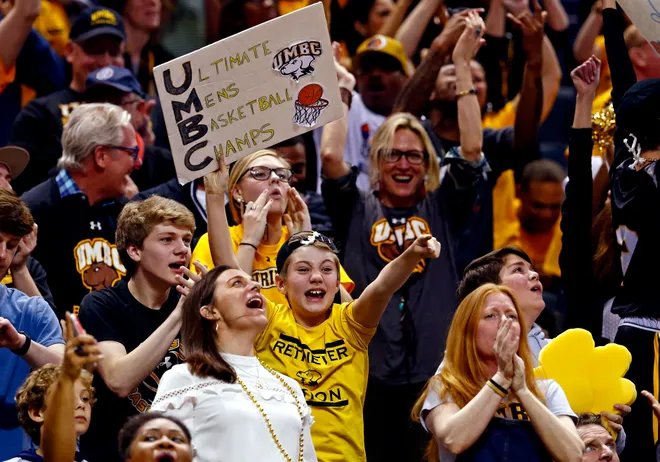Savor this NCAA men's tournament because future Cinderellas are in danger
Here’s a piece of advice for anyone who wakes up on the greatest Thursday morning in American sports with butterflies in their stomach and anticipation in their heart.
Embrace this NCAA men's basketball tournament. Savor it. Hold it tightly in your memory and mind.
Because the overlords who have seen fit to mess up everything else in college sports are coming for this American treasure, too. They don’t care about what makes March Madness special – if they understand it in the first place. They don't care about pure competition that gives schools like St. Peter’s and Fairleigh Dickinson a shot to make history. And they certainly don’t care about the fans of college basketball – be it the hard-cores or those who parachute in for a few weeks in March – who like their NCAA Tournament the way it is and don't see any reason it should be fundamentally changed.
These folks are determined to send Cinderella back home without her glass slipper or gown, not because the clock struck midnight but because they need to take them to the pawn shop for a few extra nickels.
They’re people like Greg Sankey, the SEC commissioner who chooses his words carefully and talks about bids to the NCAA Tournament as if they’re the property of major conferences being gifted to everyone else as alms for the poor.
FOLLOW THE MADNESS: NCAA basketball bracket, scores, schedules, teams and more.

“We are giving away highly competitive opportunities for automatic qualifiers (from small conferences), and I think that pressure is going to rise as we have more competitive basketball leagues at the top end,” Sankey recently told ESPN.
They’re even people like Tom Izzo, the Michigan State men's coach, who said Wednesday he’s always defended the little guy in college basketball but he’s not sure that tournament upsets are “what’s best for the game.”
If you aren't getting the picture through the careful, coded language, understand this much: Change to the NCAA Tournament is coming. And most of us probably aren’t going to like it.
It will be sold to the public as a small, necessary tweak: From 68 teams to 72 or 76. More opportunities! More games! What happened on Selection Sunday this year, with an unusual number of surprise conference champions knocking out three or four bubble teams, is only going to increase momentum for tournament expansion.
PREDICTIONS:Seven Cinderella teams who could bust your NCAA Tournament bracket
But that’s only part of the story.
For the last couple of years, the interests of the big schools Sankey cares about and those of the majority in Division I have been at cross-purposes.
The organizational structure the SEC needs to manage issues like name, image and likeness and potential revenue-sharing with athletes does not fit anymore within the same paradigm that schools like Wagner or South Dakota State operate in. The problem, though, is that there are far more Wagners and South Dakota States than Tennessees and Kentuckys within the 360-plus schools that vote on rules and issues affecting everyone.
Implicit in that divide is the threat of power conferences breaking away and doing their own thing, leaving the NCAA Tournament behind for some kind of made-for-TV event that only includes the big brands and maybe a few others who get invited to their party. That’s why when Sankey says stuff like, “I understand access, I understand the special nature (of Cinderellas) and certainly respect that, but right now in college athletics, nothing is static,” as he did last week to The Athletic, it’s fair to be a little worried.
What Sankey doesn't seem to understand – or maybe he just doesn’t care – is that fans aren’t interested in the backroom politics. They just want to see the games. And they want to see a Maryland-Baltimore County have the opportunity to face Virginia, or Fairleigh Dickinson get its shot to beat Purdue.
Because sometimes in this sport, the little guy wins. And that's why the tournament still occupies a special place in American culture, even as interest in regular-season men's college basketball seems to wane a little more every year.
MORE:March Madness expert picks: Our bracket predictions for 2024 NCAA men's tournament
“This is the holy grail for mid-majors,” Oakland coach Greg Kampe told reporters Wednesday. “The NCAA basketball tournament – and please don't change it – is one of the three greatest sporting events in the world.”
Making a fundamental change to this tournament feels so inevitable because we've seen how untethered the current leaders of college athletics are to tradition and what makes sense both intuitively and competitively.
They ripped apart the Pac-12 and sold it for pieces in a matter of days. They expanded conferences beyond any reasonable geographic or cultural ties. They decided on a 12-team College Football Playoff and then started talking about a 14-team bracket almost right away because the SEC and Big Ten wanted more guaranteed spots for themselves (details on that one are still being hashed out.)
And once you establish that the two richest conferences can do whatever they want and take whatever they want, they're not going to stop.
So of course they’re coming for the basketball tournament next. And don’t be surprised if they argue that expanding the field should come with some guarantees because the new 16-team SEC and 18-team Big Ten will be so loaded with quality teams that their records can’t be evaluated fairly against the mid-majors.
College sports have always operated on the basis that winning your conference gets you an automatic bid to the national tournament. It doesn’t matter if the SEC is better than the NEC; they each are guaranteed the same number of spots. But if the SEC and Big Ten are successful in securing more automatic bids for themselves in the new CFP, it will forever open Pandora's Box to a world that imperils the mid-majors.

Even if all 32 Division I conferences retain automatic bids to an expanded NCAA Tournament, will the new first round feature mediocre bubble teams, or will it pit the small conference champions against each other to essentially weed them out before playing the big boys?
While a 76-team tournament sounds innocuous, the practical effect is that 24 teams would be part of a play-in round, needing to win a game to reach the final 64 when the “real” tournament would actually begin.
If the Big Ten and SEC are successful in bullying the small conference champions to make up that set of 24 teams, then the rest of the matchups will look different. Instead of Morehead State vs. Illinois, you’ll get more Morehead State vs. Longwood and Illinois vs. some team that wasn’t good enough to get in the field this year.
That’s what the power conferences want.
That isn't what the public wants.
As always, we’ll see what happens. But given the current state of college sports, it’s probably coming sooner rather than later. Let's appreciate what we’ve got before they take it away.
Disclaimer: The copyright of this article belongs to the original author. Reposting this article is solely for the purpose of information dissemination and does not constitute any investment advice. If there is any infringement, please contact us immediately. We will make corrections or deletions as necessary. Thank you.







